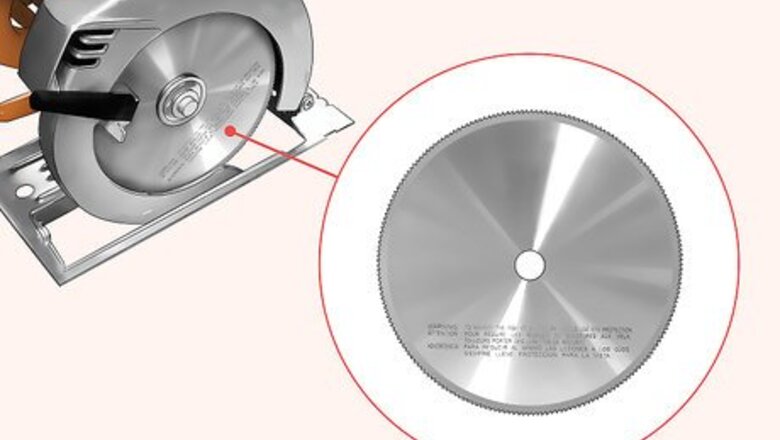
views
Cutting Plywood with a Circular Saw

Choose the right kind of blade. To get a smooth cut on a sheet of plywood, you'll need to have the right blade. Look for a carbide-tipped blade with a high tooth count. You can find blades labeled for plywood or "finished cuts," but make sure to check the tooth count. Blades come in various sizes, so be sure you get one that will fit your circular saw. If you stick with the blade that came with your saw, you'll likely end up with splintered ends, also known as tear-outs.

Set the saw blade to the right depth. Before cutting your plywood, adjust your saw blade to the right depth. If your blade is set too deep, you'll be dragging a lot of excess blade through the sheet. If you have your blade set too shallow, you run the risk of not cutting all the way through the sheet. You want your saw to be about .25 inches (0.6 cm) below the sheet. If you're cutting a sheet of plywood that is .75 inches (1.9 cm) thick, set your blade to 1 inch (2.5 cm) deep.

Support the whole piece of wood. When cutting a sheet of plywood, it's important that you support the sheet on both sides of the cut. A few long 2x4s laid across two sawhorses will keep the sheet steady as you cut. Keep the 2x4s handy just for this task, as you'll be cutting into the tops of them with your circular saw. If you don't have access to 2x4s or sawhorses, you can use a piece of rigid foam insulation instead. Lay the foam on the ground, and lay the sheet of plywood on top. Make sure the wood doesn't slide around on top of the foam board. If you use the foam board method, you can crawl across the board as you cut, and you don't have to worry about the board snapping off at the end of the cut.
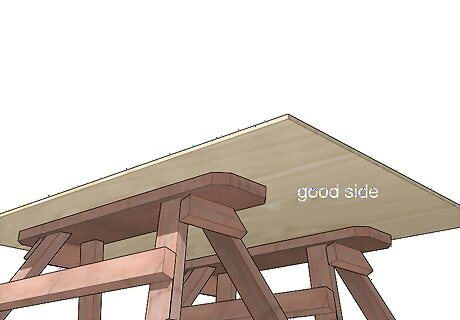
Cut with the good side down. When using a circular saw, place your plywood on the cutting surface with the good face down. The teeth of the blade enter the sheet from underneath, and exit at the top. When the teeth exit, they may cause some chipping. Placing the sheet with the good face down will ensure a smooth surface.

Mark your cutting line. Use a straight edge to mark your line. Measure carefully and make sure you have the cutting line square with the edge of your plywood. For a smoother cut, score your line. Use a utility knife to score your line before you cut. You may have to run your knife over the line a few times to get it to score completely. A good rule to follow is "measure twice, cut once." If you cut the wood wrong, you can't do much to fix it other than start over with a new piece of wood.

Use a guide to cut. Find a piece of plywood that still has its factory edge and attach it to your cutting surface using clamps. Take into consideration the width of the saw's base plate, or shoe. Adjust your guide so that the shoe fits firmly against the guide, and the blade is in line with your cut mark. If you are planning on cutting a lot of plywood, you might consider investing in a saw guide that attaches to your circular saw. Look online or in your local hardware store to find one that suits your needs.
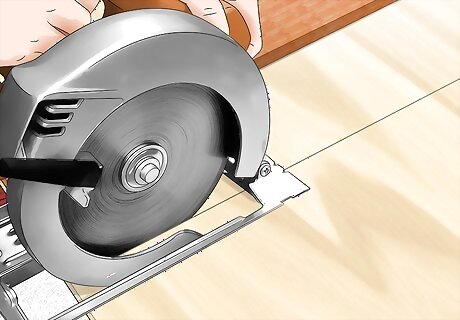
Make your cut. Line your saw up with your guide, and make sure the blade is over your cut mark. Turn your saw on, and run the shoe of the saw along your guide. Take care to make your cut as straight as possible. Using a saw is dangerous. Wear safety goggles at all times, and keep your fingers clear of the blade. Watch out for the power cord as you cut. Keep your work area clean.
Cutting Plywood with a Table Saw
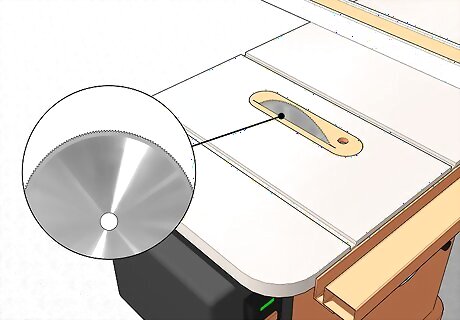
Choose the right blade. You can use a table saw to cut plywood. To get the smoothest cut from your table saw, invest in a blade with a high tooth count, such as an 80 TPI plywood blade. Most stock blades on table saws work well for rough cuts, but will not give you a clean edge. Alternatively use a zero-clearance insert under the plywood. To make one of these, carefully set a piece of wood or plywood onto the working table saw, taking care not to have the wood slip or pull from your hands. Once the blade is all the way through (the blade needs to be quite high), clamp the insert down. You will be cutting on the insert, which does not allow the bottom layer of plywood to chip downward because of the low clearance between the blade and the insert. The insert is sacrificial and it's usually only sensible to make one when cutting large amounts of plywood.
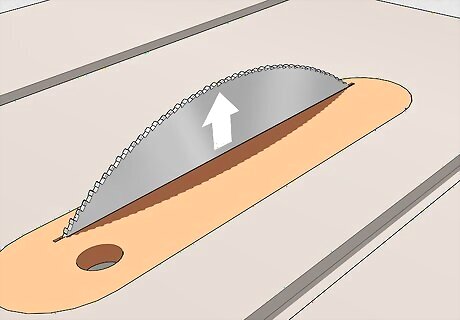
Raise the blade. Raising the blade changes the direction the teeth will enter the wood. When the blade is slightly raised, such that the teeth just barely cut through the surface, the teeth enter the cutting surface at an angle. If you raise the blade a little higher, you can get a perpendicular cut, which will make a smoother surface. Don't raise the blade more than 1 inch (2.5 cm) above the cutting surface. A raised blade may offer a smoother cut, but it also makes for a more dangerous cut. Exercise extreme caution when cutting with a raised blade.
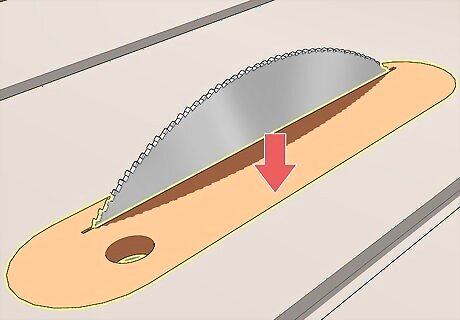
Use a zero-clearance insert. Your table saw may have a gap between the blade and the throat plate, where the blade sits in the table saw. A zero-clearance insert closes the gap and offers support to the sheet, making a smoother cut. You can purchase a zero-clearance throat plate online or at your local hardware store. Alternatively make your own. First, carefully set a piece of wood or plywood onto the working table saw, taking care not to have the wood slip or pull away from your hands. Once the blade is all the way through (the blade needs to be quite high), clamp the insert down. You will be cutting on the insert, which does not allow the bottom layer of plywood to chip downward because of the low clearance between the blade and the insert. The insert is sacrificial and it's usually only sensible to make one when cutting large amounts of plywood. To make safe cuts, make sure that whatever you're cutting isn't at an angle or unsupported on the other side.
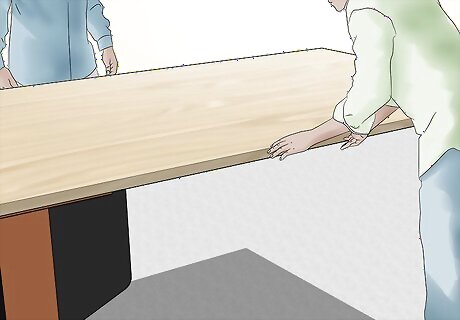
Support the entire sheet. Large pieces of plywood can get heavy. When cutting them on a table saw, make sure you can keep it flat before beginning your cut. Stabilize the sheet on sawhorses, or ask a friend to help you hold it steady. Having the entire sheet supported allows you to keep a steady feed rate, that is, the speed you run the wood through the saw. You can also use a circular saw to break down large sheets to more manageable sizes.

Tape off your cut mark. Use a low-adhesion tape, such as painter's tape, on both faces of your sheet. This will help hold the wood fibers in place and keep the edges from splintering. Once you have finished cutting, peel the tape off slowly to avoid any splintering.
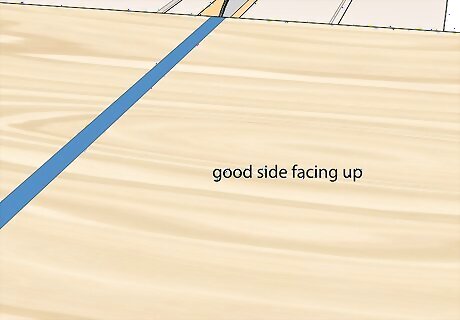
Cut with the good face up. Lay your sheet on your table saw with the good face up. The teeth of the saw will enter the sheet from the top and exit from the underside of the sheet. Tear-outs, or splintering, will occur where the teeth exit, so keep the good face up.

Make the cut. Hold your sheet steady and keep it pressed firmly against the fence, the straight edge of your table saw. Use both hands to guide the sheet through the blade. Use the hand that is closest to the blade to press the sheet forward, through the blade. Use the hand that is furthest from the blade to press the sheet towards the cutline. As you get close to the end of the cut, move your hands so that you have one hand on either side of the blade. Carefully push the rest of the sheet through the blade. Work carefully when using your table saw. Keep your hands away from the blade.
Making a Plunge Cut
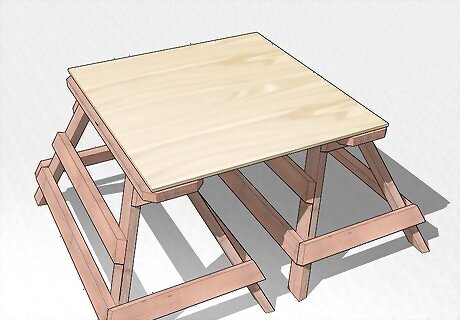
Make sure the sheet is stable. Lay your sheet of plywood on a few 2x4s suspended over two sawhorses. The entire sheet of plywood should be seated firmly on the work surface. A plunge cut is a cut that does not start from a straight edge, but the center of a sheet of plywood. If you need to make an opening in the middle of a sheet of plywood, for example, you would need to make a plunge cut.
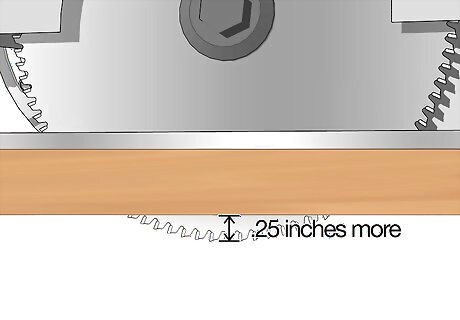
Set the blade depth. Lower the blade to about .25 inches (0.6 cm) more than the thickness of your sheet. This will ensure the teeth of the blades just barely cut through the underside of the surface.
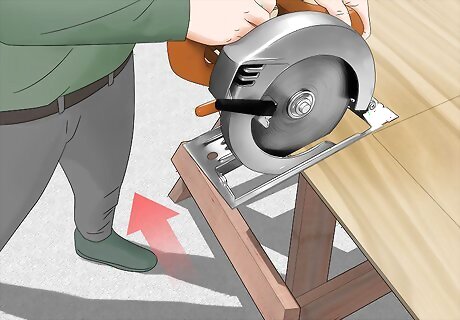
Stand to the side of the saw. There is a high risk of kick back, or the saw running back towards you, when making a plunge cut. Do not stand directly behind the saw when you make a plunge cut.

Position your saw for a plunge cut. Place the front edge of the shoe, or the base plate of the saw, against your sheet of plywood. Carefully lift up the blade guard, and line the blade up with your cut mark.

Keep the underside of the blade clear. You won't be able to see what is beneath the sheet as you make your plunge cut, so check before hand to make sure the space is clear.
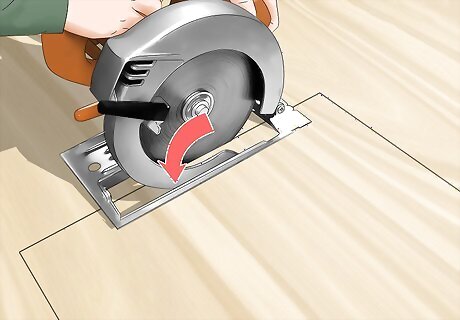
Lower the blade into the plywood. Turn the saw on and slowly lower the saw blade into the sheet. Hold the saw firmly to keep it from kicking back to you. Once the saw is completely lowered into the cut, and the saw bed is flush with the cutting surface, release the blade guard. Move the saw forward to finish the cut. Let the blade come to a complete stop before lifting the saw out of the sheet.
Cutting Plywood with a Hand Saw
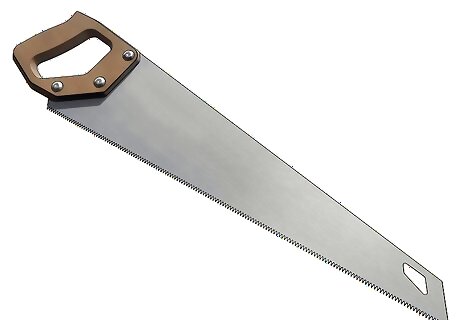
Buy a good saw. If you don't have access to power tools, you'll need to invest in a solid crosscut saw. Look at a saw's TPI, or teeth per inch. A saw with fewer teeth will cut faster, but you'll be left with a rough edge. A saw with a higher TPI will leave you with a smoother edge, but it will take some time to saw. Make sure the handle is comfortable when you grip it, and look down the back of the saw blade to make sure it is straight. The tip of the saw should be flexible. When you bend it, it should snap back to the center.

Measure your cut. Anytime you are working with wood, make sure to measure your cut. Once the wood has been cut, there is no turning back. Double check your measurements before cutting.
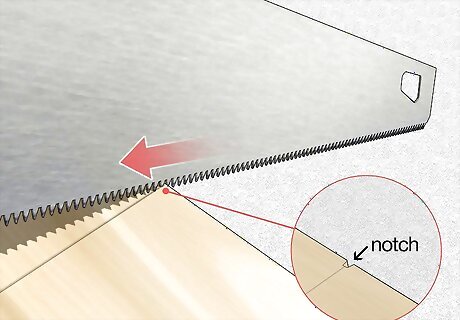
Notch the wood. Start on the edge of the board, and hold the saw blade upright. Draw the saw up a few times to get a notch in the edge of the board. You can use your thumb knuckle to guide the blade, but be careful.

Start the cut. When you've made a solid notch in the edge, bring the saw to about 45-30 degrees. Work carefully and use smooth, full strokes to cut plywood. Keep your forearm and shoulder in line with the blade to ensure a straight cut. If you notice the blade running off track, give the handle a little twist to set it right.

Brace the cutoff end to avoid splinters. When you get towards the end of your cut, use your free hand to hold the cutoff end. Turn the saw upright and use short vertical strokes to finish the cut.












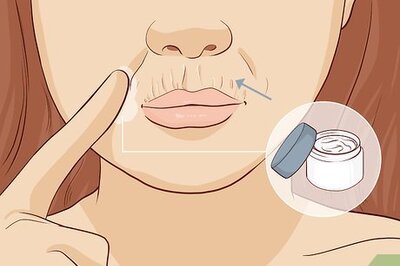



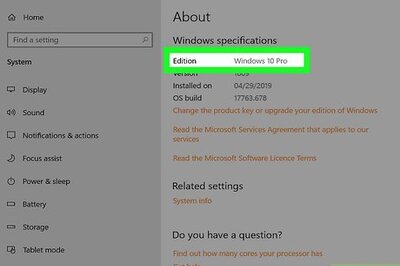

Comments
0 comment